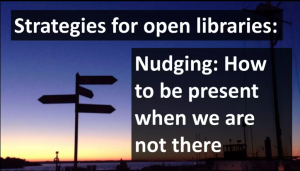In module three, the Hyperlink Library Model is explored with emphasis on participatory services and how important it is library services are adaptable and changing to fit the needs of their users, one of the trends discussed in the Hyperlinked Library Model lecture was the Open+ self-service used at the Gwinnett County Public Library’s Lawrenceville Branch. I was surprised to find that this wasn’t just a self-checkout model of service like with the self-checkout machines that are now gaining (and waning) in popularity, but rather access to an unstaffed library that can accommodate user-friendly self-services without the need of having staff present. Bibliotheca (n.d.) outlines this comprehensive service in their resource guide “Once inside the library, patrons can use the self-service kiosk facilities to issue, return and renew items or pay fees and fines, just as they can during staffed hours, as well as using the library public access PC facilities or using other library facilities made available.” I have included a video below from Bibliotheca to further showcase this interesting and very trusting service! My first question about this service which allows patrons to roam an unstaffed library was how does this concept of self-service in a library equate to a thriving participatory service that encourages interaction between library staff and the patrons they serve?
Further reading into the topic of the Open+ system led me to an interesting blog post by Danish librarian Jan Holmquist and his keynote summary on the concept of “open libraries” and how these self-service libraries have become integral to the survival of libraries across Denmark. In fact, as of 2019, 88% of Denmark’s libraries are accessible outside of staffed hours. (Holmquist, 2016) Much like the Open+ service, the libraries utilize a locked location accessible by a library card, RFID tracking for materials, camera surveillance for monitoring, self-checkout machines, and access to public computers (and coffee!)
One of the strategies that Holmquist (2016) addresses in his keynote is the concept of “nudging” where patrons are encouraged to help one another during self-service hours as a way to facilitate the sharing of books that they enjoyed with one another. Hehighlights that the open library concept has benefited communities with the increased accessibility of learning spaces and has “made their communities smarter” (Holmquist, 2016).
Denmark’s adoption of the open library model has brought some sobering statistics to light in that the adoption of the concept was one of the only plausible alternatives to prevent their libraries from closing for good. While staff hours have been cut in favor of expanding self-service hours, they have seen that library use declines at locations with only self-staffed hours (Holmquist, 2016).
In Automatic for the People, the issue of staffing is brought up during the discussion of implementing a self-service open library model. Gwinnett County Public Library’s customer service director explains that rather than cutting staff, they utilized the service to increase the hours of locations to add value to the services that their library system provides (Zulkey, 2019). Interestingly they do note that an on-call security service is utilized in the evenings to offer additional security when staff is not available.
As my library self-service experiences have been in the sphere of self-checkout machines, book vending machines, and DIY holding shelves (which still makes me anxious to think about) the idea of an open library was a very interesting concept to read about. I have always been interested in self-service as I am deaf and self-service is often the easiest service for me (I am going to miss the Target self-checkout kiosks tremendously) so this service concept is something that I am interested in using, or at least experience. I do worry about the pros and cons of an open library model in a public library setting due to issues experienced while the library is typically staffed such as patron safety and privacy, facility damage, and theft, however, these issues can most likely be mitigated with careful planning and an understanding of the communities needs and demographic awareness.
References
Bibliotheca. (2018, May 16.) open+ introduction | community-focused explainer video [Video].https://www.youtube.com/watch?v=Vvje4eNXcCk
Holmquist, J. (2016, April 6). Open libraries: Self-Service libraries The Danish Way. World wide thoughts of a Danish librarian. https://janholmquist.net/2016/04/06/open-libraries-self-service-libraries-the-danish-way/
open+ access (n.d.). Biblotheca.
https://assets.applytosupply.digitalmarketplace.service.gov.uk/g-cloud-13/documents/702627/144969718839855-service-definition-document-2022-05-16-1513.pdf
Stephens, M. (2019). Hyperlinked Library Model. [Lecture Video]. San Jose State University.
Zulkey, C. (2019). Automatic for the people. American Libraries. https://americanlibrariesmagazine.org/2019/09/03/automatic-people-self-service-libraries/


